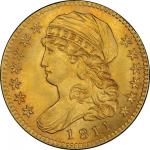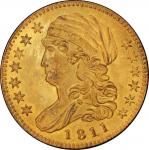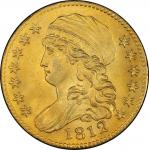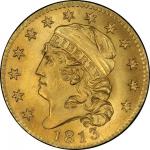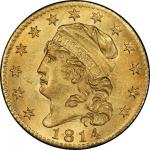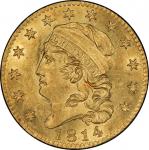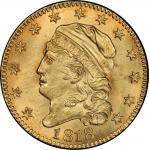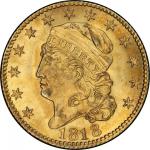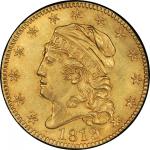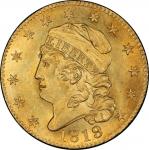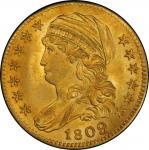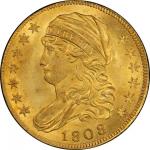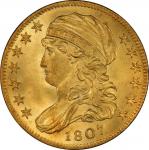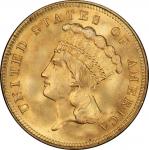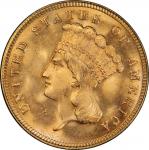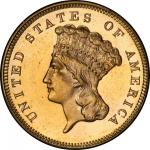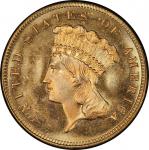“I wish you to procure and send to me a specimen of every one of the coins of the Mint of the United States, of gold, silver and copper, viz: an eagle, half eagle, quarter eagle, dollar, half dollar, quarter dollar, ten cent and five cent piece, cent & half cent. As new as you can procure them, or at least perfect in execution, and undefaced. I want them for a collection. Perhaps by the friendship of Dr. Rush, you can procure them new, from the Mint. And to save the trouble of forwarding them to you, perhaps he will be kind enough to send them to me, by some spring vessel from Philadelphia. You will transmit to him the amount of their value, and charge it account to me.” — John Quincy Adams to Thomas Boylston Adams, October 27, 1810 This variety has been generally acclaimed as the most frequently encountered of the type, however gems remain extremely rare. The D. Brent Pogue Collection includes a pristine survivor from this die pair, the single finest of the date graded by PCGS. The surfaces are frosty and light yellow, a bit deeper near the rims, tinted with the faintest green in the fields. Only the most shallow signs of handling are seen, of the sort of contact few coins could leave the Mint without receiving. The peripheral strike is bold, though the centers show some softness, notable on Liberty’s cheek and the eagle’s wing at left. Some extremely faint evidence of planchet adjustment is seen at the central obverse. A fascinating pair of die clashes are visible, matching an impression of the denticles and the base of the denomination on the northeast quadrant of the obverse with an impression of the top of Liberty’s head atop the denomination. Some raised artifacts from pits in the die face are seen in Liberty’s lowest curl; the vertical lapping lines above the second 1 in the date almost certainly remain from an attempt to efface them. Two similar pits in the space between STATES and OF are likely the genesis of the single long lapping line that remains in that region, crossing S at its centerpoint before touching the denticles above. President James Madison appointed John Quincy Adams as Minister to Russia in 1809, following Adams’ single Senate term that ended with political calamity. Adams’ posting in Saint Petersburg took him far from most family and friends, but allowed him to revisit a city that had hosted him in the early 1780s, when the teenaged diplomat had served as the secretary to Minister Francis Dana. Now a politically savvy and learned 42 year old, Adams and his wife Louisa became closely acquainted with the Enlightenment-minded Alexander I, who was so well regarded in America that Thomas Jefferson kept a bust of the czar in his parlor at Monticello. Alexander, like most monarchs of the era, was a collector of all manner of historical items, coins and medals included. When John Quincy Adams wrote to his younger brother Thomas requesting “a specimen of every one of the coins of the Mint of the United States” in October 1810, he clearly knew to expect coins that were not all of the same year. Having requested an eagle, last struck in 1804, a mismatched collection was guaranteed. By the time the letter made its way from Russia to Quincy, Massachusetts, months had passed. Months more passed before the set of coins was acquired, but Thomas Boylston Adams successfully fulfilled his brother’s request: “I have procured for you a complete set of the U.S. coins,” Thomas Boylston Adams wrote on April 7, 1811. “They are so neatly done up in papers that I did not undo any, and I have delivered them to Captain Boit of the Ship Cordelia, which will sail in a few days for St. Petersburg, where I hope you well receive them in a good condition.” Minister Adams’ reply of July 31, 1811, included a brief postscript that represents the last word on the set of coins he requested: “P.S.—The coins and books by Captain Boit came safe—I thank you for them.” Since the Adams set was likely a diplomatic gift meant for the Czar, it may survive somewhere in the depths of the Hermitage. If it is ever located, it would be an international sensation. An example of this date from the Mint Cabinet, now in the National Numismatic Collection at the Smithsonian Institution, offers a clue of how well an institution can preserve a coin of this vintage: the Mint Cabinet specimen has been graded “MS-66 or better” by John Dannreuther. Should the John Quincy Adams coin still exist, it is unlikely to be finer than this specimen. This coin is “as fresh as the day it was minted,” in the words of the catalog of Auction ’84, where it was last offered for sale. Gems of this quality are extremely rare everywhere but in the D. Brent Pogue Collection. In 30 years, PCGS has graded exactly six half eagles of this design type finer than MS-65. Three of them have been graded MS-66, along with single coins graded MS-66+, MS-67, and MS-67+. Each and every one of those coins is in the present catalog. Beyond the confines of this amazing collection, this piece is unsurpassed among specimens of this date or design type. PCGS# 507598. NGC ID: 25PG.

